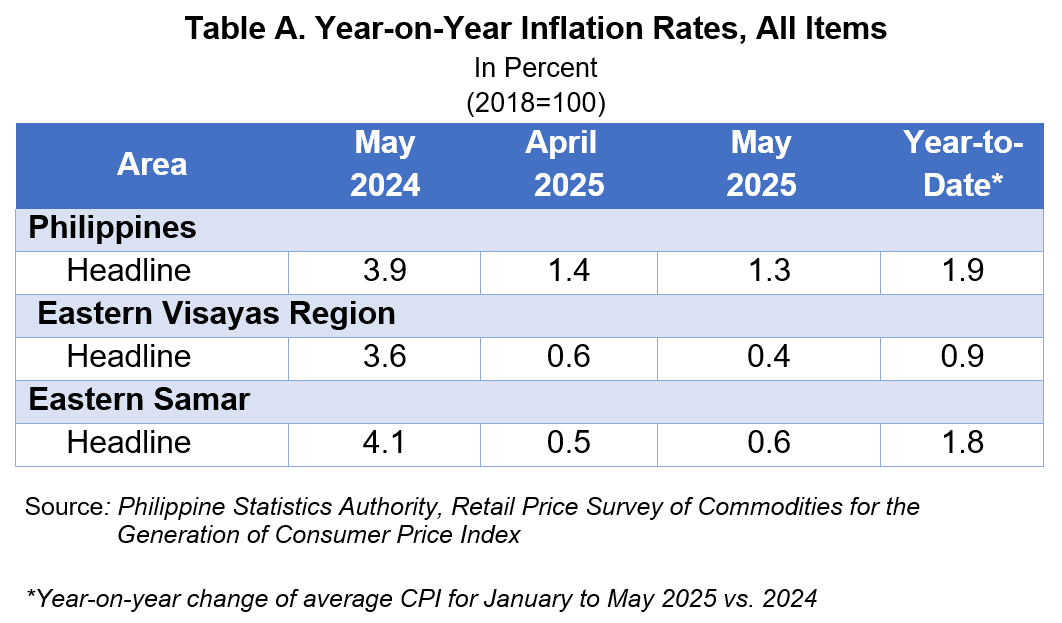
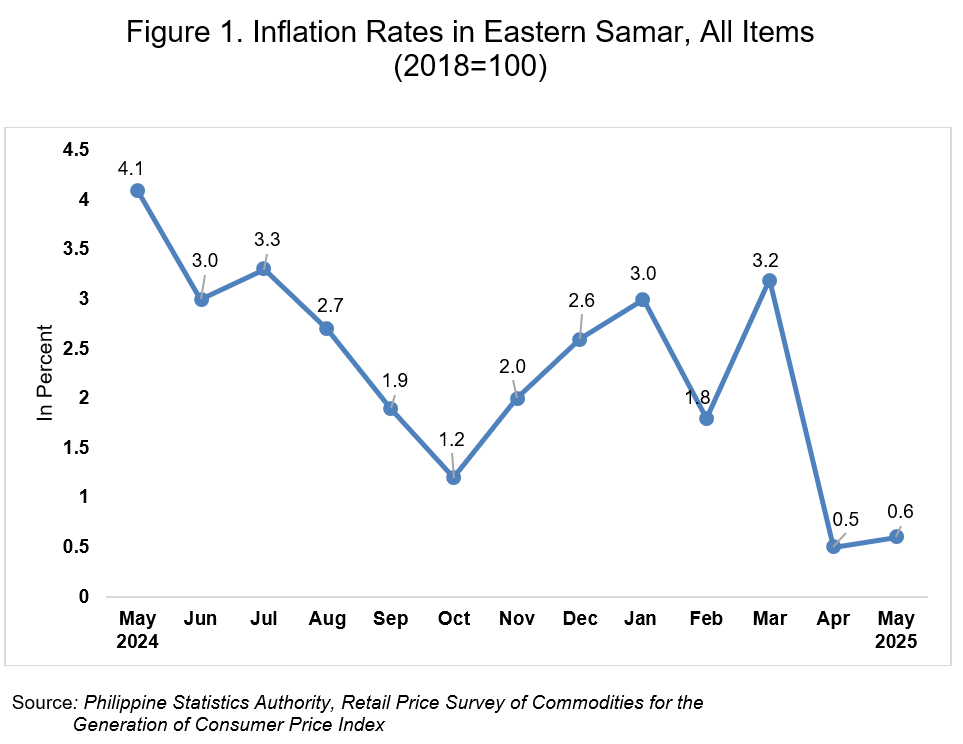
EASTERN SAMAR
1. Headline Inflation
Inflation Rate (IR) in Eastern Samar accelerated to 0.6 percent in May 2025 from 0.5 percent in April 2025. This is 0.2 percentage point higher compared to the 0.4 percent IR in Region VIII and 0.7 percentage point lower than the 1.3 percent IR of the Philippines. In May 2024, the inflation rate was 4.1 percent, higher by 3.5 percentage points compared to this month’s rate. (Figure 1, and Tables A and B)
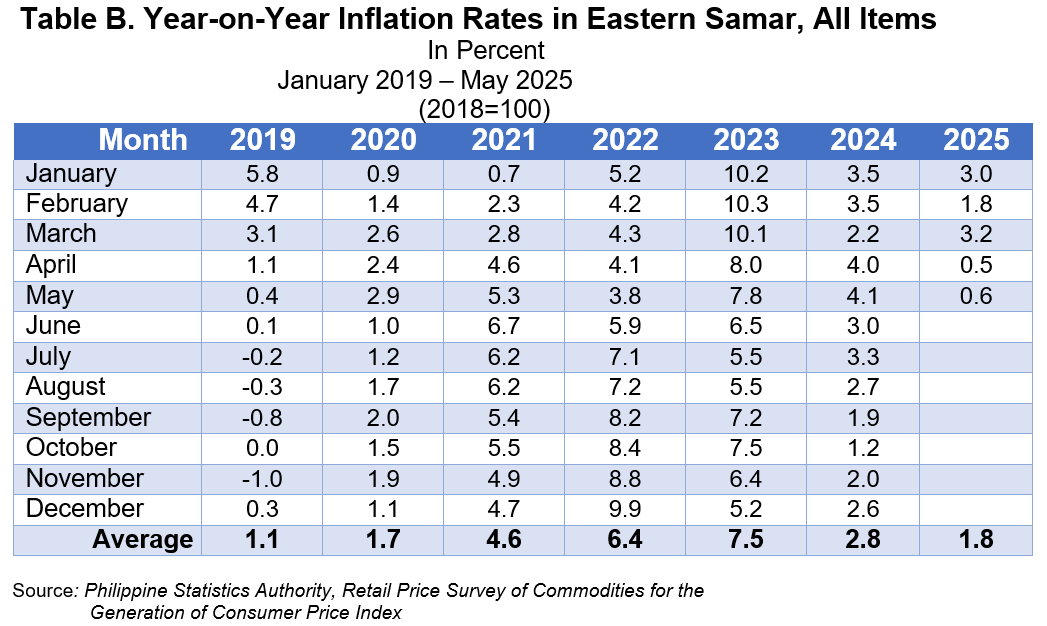
Main Drivers of the Upward Trend of Eastern Samar’s Inflation
The upward trend in the province’s inflation rate in May 2025 was mainly driven by the annual increment of housing, water, electricity, gas and other fuels at 7.0 percent from a 2.6 percent annual increase in April 2025. Also, personal care, and miscellaneous goods and services, which recorded a 1.5 percent inflation rate from an annual increase of 1.3 percent, and the faster inflation rate of health at 0.5 percent from a 0.4 percent annual increase in the previous month, contributed to the upward trend of the province’s inflation. (Table C)
On the other hand, the following commodities registered slower inflation rates in May 2025:
(a) Alcoholic beverages and tobacco, 1.9 percent from 2.1 percent;
(b) Clothing and footwear, 1.2 percent from 1.4 percent;
(c) Furnishings, household equipment and routine household maintenance, 2.6 percent from 2.7 percent;
(d) Information and communication, 0.2 percent from 0.3 percent; and
(e) Recreation, sport and culture, 1.0 percent from 1.3 percent.
On the other hand, compared with their previous month’s inflation rates, faster annual decline was recorded in the heavily-weighted food and non-alcoholic beverages at 2.2 percent from 0.7 percent and transport at 2.4 percent from 1.6 percent.
Meanwhile, education services, restaurants and accommodation services, and financial services maintained their respective previous month’s inflation rates at 0.0 percent, 4.6 percent, and 0.0 percent, respectively.
Top Three Main Contributors to Eastern Samar Inflation
The following commodity groups were the top three contributors to the May 2025 inflation of the province of Eastern Samar:
a. Housing, water, electricity, gas and other fuels with 248.6 percent share or 1.49 percentage points;
b. Restaurants and accommodation services with 38.4 percent share or 0.23 percentage point; and
c. Furnishings, household equipment and routine household maintenance with 20.6 percent share or 0.12 percentage point.
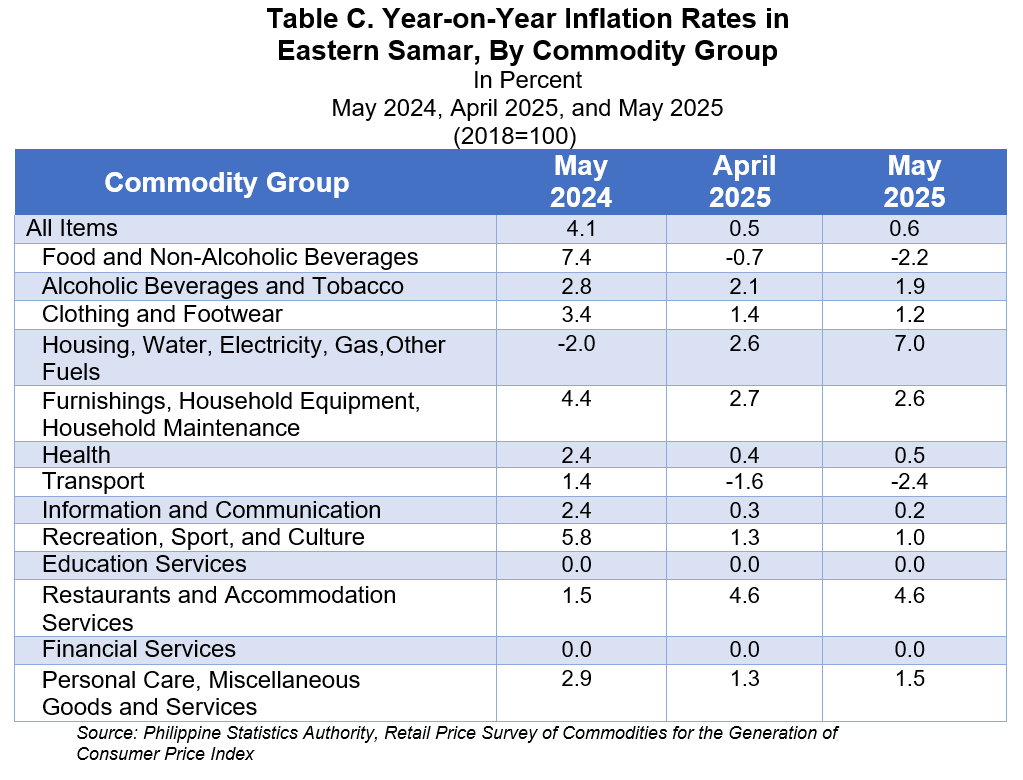
2. Food Inflation
Inflation rate of food in the Province in May 2025 further declined to
2.5 percent from an annual drop of 1.0 percent in the previous month. In May 2024, food inflation was higher at 7.9 percent. (Table D)
Main Drivers of the Downward Trend of Food Inflation
The downward trend of food inflation in May 2025 was primarily due to the faster annual decline of cereals and cereal products at 11.2 percent from an annual drop of 6.7 percent in April 2025. Also, the slower annual increase of vegetables, tubers, plantains, cooking bananas and pulses at 9.2 percent from an annual increment at 13.9 percent, and meat and other parts of slaughtered land animals which slowed down to
6.6 percent from 7.1 percent in the previous month contributed to the downward trend of the province’s food inflation.
Also, milk, other dairy products and eggs registered a slower annual increase at 2.9 percent in May 2025 from 3.0 percent in April 2025.
On the other hand, the following food groups recorded faster annual inflation rates in May 2025 compared to that in the previous month:
(a) Fish and other seafood; 2.0 percent from -2.3 percent;
(b) Oils and fats; 0.5 percent from -0.1 percent;
(c) Fruits and nuts; 0.1 percent from -2.1 percent;
(d) Sugar, confectionery and desserts; 1.3 percent from 1.0 percent; and
(e) Ready-made food and other food products not elsewhere classified; 4.8 percent from 4.6 percent.
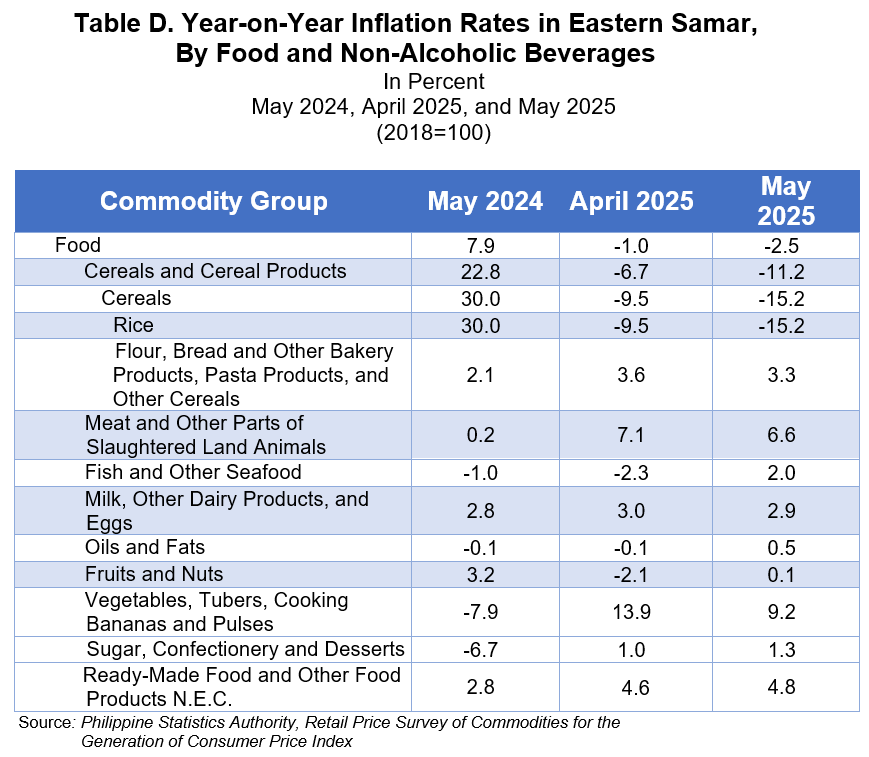
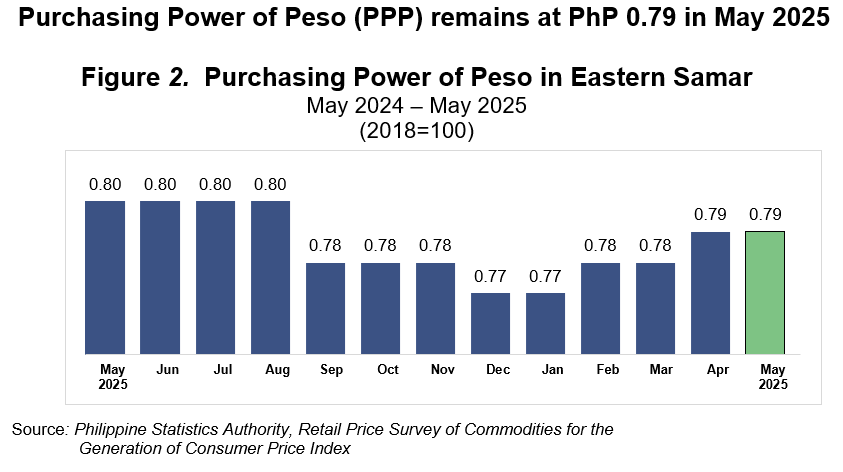
For this month, the Purchasing Power of Peso (PPP) in Eastern Samar remains at 79 centavos. This indicates that the peso in 2018 has a value of 79 centavos in May 2025. (Figure 2)
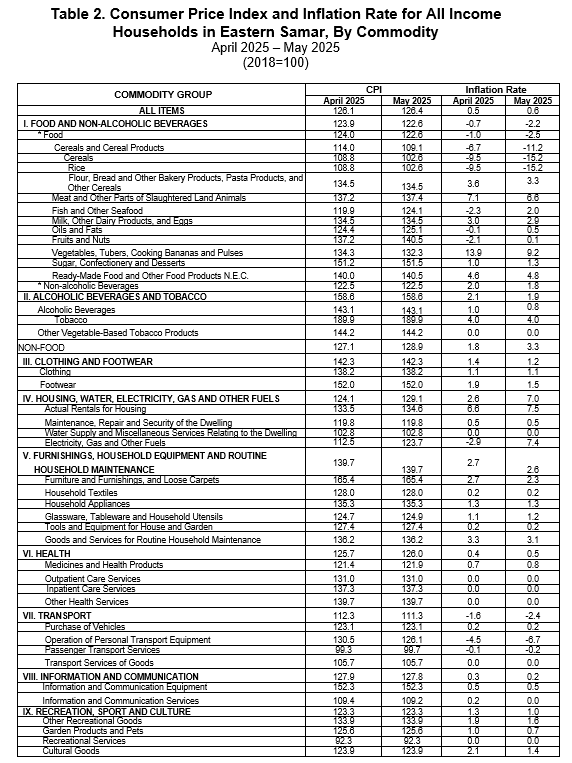
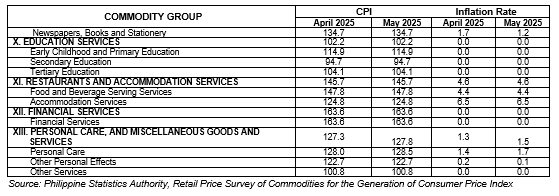
TECHNICAL NOTES
Consumer Price Index (CPI) - is an indicator of the change in the average retail prices of a fixed basket of goods and services commonly purchased by households relative to a base year. It shows how much on the average, prices of goods and services have increased or decreased from a reference period known as the base year. The current CPI series is 2018-based.
The 2018 FIES expenditure data were used to directly estimate the 2018 CPI weights at the national and regional levels. However, the 2018 FIES estimates for the expenditure data at the provincial level were not directly utilized in estimating the CPI expenditure weights as the data at the provincial/city level may not be reliable with the use of the households' master sample (MS) that was utilized in selecting the 2018 FIES sample households. The MS was drawn using regions as domains in generating estimates in all the household surveys of the PSA starting July 2013. The provincial/city expenditure data were derived using the model-based method in small area estimation procedures using the regional expenditure data as the control total for all the expenditure data within the specific region. Using these estimates, the weight for each item of expenditure is computed as a proportion of that item of expenditure to the total national expenditure. A raking procedure was done to adjust the weights of the provinces so that the provincial weights when added up will equal to the regional weights.
The formula used in computing the CPI is the weighted arithmetic mean of price relatives, a variant of the Laspeyres formula with fixed base year period weights as shown below:
∑ [(Pn / P0) * (P0*Q0)]
CPI = X 100
∑(P0*Q0)
where Pn = current price
P0 = base year price or base price P0 * Q0 = base year weights
Base Period or Base Year - is the period, usually a year, at which the index number is set to 100. It is the reference point of the index number series.
Market Basket - is a term used to refer to a sample of goods and services that are commonly purchased and bought by an average Filipino household.
Inflation Rate (IR) - is defined as the annual rate of change or the year-to-year change in the CPI and is computed as:
(CPI2 – CPI1)
Inflation Rate = X 100
CPI1
where CPI2 = is the CPI in the second period CPI1 = is the CPI in the previous period
Purchasing Power of the Peso (PPP) - is a measure of the real value the peso in a given period relative to a chosen reference period. It is computed by getting the reciprocal of the CPI and multiplying the result by 100.
PPP = (1/CPI (All Items) *100
FOR THE CHIEF STATISTICAL SPECIALIST:
SUZANNE B. AMOSCO
(Supervising Statistical Specialist)
Officer-In-Charge

